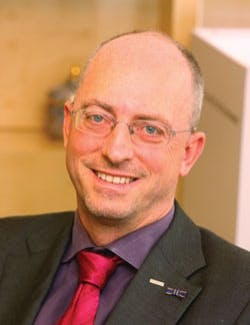Dutch Dynamo: Taking on the Wastewater Energy Challenge
Environmental biotechnologist Professor Mark Van Loosdrecht is the winner of this year's Lee Kuan Yew Water Prize for helping to integrate the use of Anammox in wastewater treatment. Here he catches up with WWi magazine on the development of the technology and his predictions on future water reuse.
Firstly Prof van Loosdrecht, congratulations on winning the 2012 Lee Kuan Yew Prize. Tell us how your process – Anammox – came about?
In the sixties and seventies, people regularly reported that ammonium was mysteriously disappearing from treatment systems. It was Arnold Mulder in Delft who did a similar observation, but then decided not just to report it but also to investigate it. And it was microbiologist Prof. Kuenen who dared to postulate that this was a completely unknown microbial process.
It took many years to indeed prove that Anammox bacteria exist, mainly because of their slow growth rate (which is also how they escaped attention before). Knowing these bacteria exist, we realised that this is a great opportunity for a paradigm shift in wastewater treatment: the shift from energy consumption to energy conversion.
So from the mid-nineties onwards, we have been working on concepts to introduce Anammox bacteria in wastewater treatment. Currently, we are investigating the potential for municipal wastewater on side streams, industrial wastewater and in pilot plants.
How did this compare to existing wastewater treatment processes at the time?
Normally, ammonium is removed by oxidising it first to nitrate (at the expense of aeration energy), and then nitrate to nitrogen gas (at the expense of organic carbon, which otherwise could have been converted into biogas). In the Anammox process, ammonium is directly converted in nitrogen gas, requiring no organic carbon and minimal use of energy. The microbiological paradigm shift was that bacteria do not need oxygen to oxydise ammonium.
Last year's Lee Kuan Yew Prize winner, Dr James Barnard, was also awarded for his work in wastewater treatment and reuse. Surely it's not a coincidence this theme has been awarded two years in a row? There has been a lot of attention directed towards better and more efficient nutrient removal and recovery systems in the past decade (partly driven by need for water reuse), and this gave room for breakthrough innovations.
The Anammox process has been touted as helping to reduce overall energy consumption, chemical usage and carbon of a wastewater treatment plant. How much per m3 can the process reduce the cost of wastewater treatment/reuse?
This is a difficult question. These costs partly depend on local situations, for example, local energy taxation. Let's say that the Anammox process will require similar costs but make the overall treatment of wastewater more sustainable (less consumptions of resources and lower climate footprint). In many cases, 10% - 50% cost reduction can also be obtained depending on local conditions.
Do you expect PUB to roll out this process commercially following a pilot trial? The potential we have seen and the fact that temperatures are higher in Singapore (compared to e.g. Netherlands) are beneficial for the process that I expect will be introduced in Singapore. Side streams from sludge digestors can be a very short term process, but the full wastewater treatment process will take a bit longer since process development has to take place and will involve very large infrastructural works.
Your technological process has been brought to reality and implemented by Paques in 16 reference plants. Other university R&D projects aren't so lucky with funding and partnerships to be commercialised. How do you think there should be more collaboration between the industry and academia?
In 1990, no companies were interested in collaboration and without academic funding, we wouldn't have the chance to investigate what was going on. Once we understood the process and started to think about real field applications, it was indeed very beneficial to collaborate with the industry and water boards; not always directly from funding but also by asking the right questions with respect to full scale applications. I have noticed that often, when universities develop a new technology, they want to develop it fully within the university. However, I do not think this is a task for universities, and moreover, a university is not really fit to develop commercial full scale processes.
How do you think wastewater will be treated/reused in 10 years time?
Water reuse will be essential in many places, but it is not necessary to do this by definition in a short cycle. Adequate water management and distribution is more important. Wastewater reuse for specific applications is not a problem. Wastewater reuse for drinking water is not a technical or health problem, but a perception problem. I am not sure if that is easy to solve. On the other hand, we only drink a very small fraction of our total water usage.
I see that you are also credited the development of other processes, including Sharon, Nereda and CANON. What can we expect to see from you in the coming years?
The Nereda technology is just now on the market. It makes wastewater treatment 25% cheaper and reduces plant footprint by approx. 70%. I foresee this will become the major municipal wastewater technology in the coming decade. Anammox conversion can be integrated in this process to further reduce energy demand. The next step will not only be recovery of water but also of resources. These are (in colder climates) the heat content of the water, the nutrients (especially phosphate) and organic carbon as chemicals. In a cradle to cradle context, the recovery of chemicals is more important than the recovery of energy.
More Water & WasteWater International Current Issue Articles
More Water & WasteWater International Archives Issue Articles

